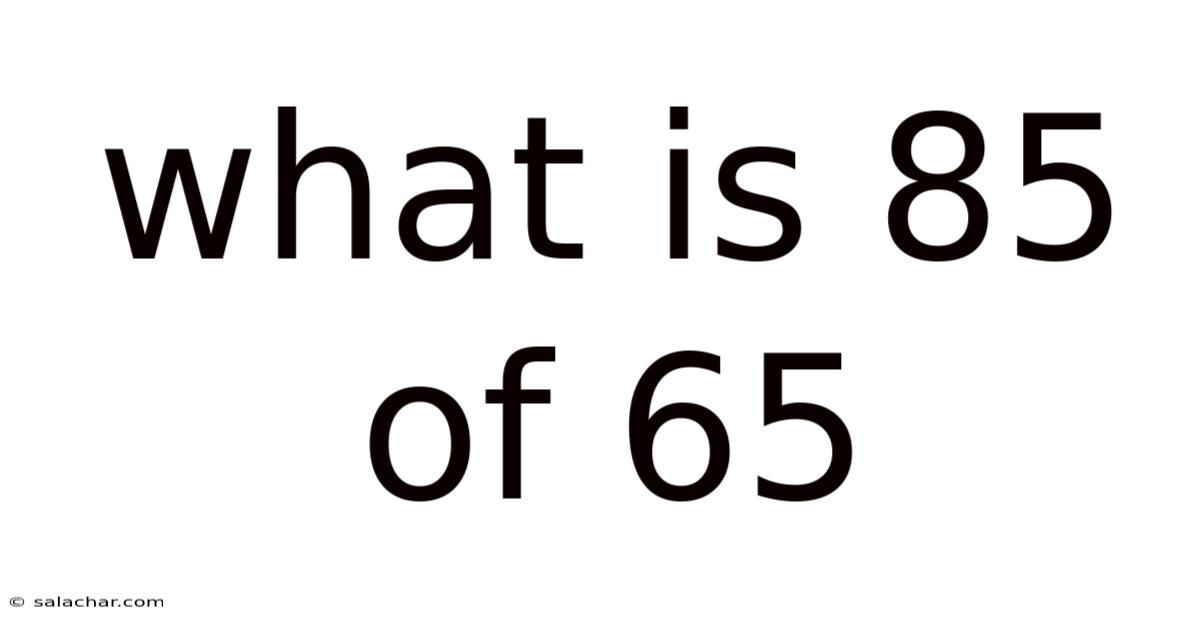What Is 85 Of 65
salachar
Sep 15, 2025 · 4 min read

Table of Contents
What is 85% of 65? A Deep Dive into Percentages and Their Applications
Finding 85% of 65 might seem like a simple calculation, but understanding the underlying principles of percentages unlocks a world of practical applications in everyday life, from calculating discounts and sales tax to understanding statistical data and financial reports. This article will not only answer the question "What is 85% of 65?" but also delve into the methods used to solve such problems, explore the significance of percentages in various fields, and address frequently asked questions.
Understanding Percentages
A percentage is a fraction or ratio expressed as a number out of 100. The symbol "%" is used to denote percentages. For instance, 85% means 85 out of 100, or 85/100, which simplifies to the decimal 0.85. Understanding this fundamental concept is crucial for solving percentage problems.
Calculating 85% of 65: Three Methods
There are several ways to calculate 85% of 65. Let's explore three common methods:
Method 1: Using Decimal Conversion
This is arguably the most straightforward method. We convert the percentage to its decimal equivalent and then multiply it by the number.
- Convert the percentage to a decimal: 85% = 85/100 = 0.85
- Multiply the decimal by the number: 0.85 x 65 = 55.25
Therefore, 85% of 65 is 55.25.
Method 2: Using Fraction Conversion
This method involves converting the percentage to a fraction and then performing the multiplication.
- Convert the percentage to a fraction: 85% = 85/100
- Simplify the fraction (if possible): 85/100 simplifies to 17/20
- Multiply the fraction by the number: (17/20) x 65 = 1105/20
- Simplify the result: 1105/20 = 55.25
Again, we find that 85% of 65 is 55.25.
Method 3: Using the Proportion Method
This method sets up a proportion to solve for the unknown value.
- Set up a proportion: 85/100 = x/65 (where x represents 85% of 65)
- Cross-multiply: 85 x 65 = 100x
- Solve for x: 5525 = 100x => x = 5525/100 = 55.25
Once more, the calculation confirms that 85% of 65 is 55.25.
The Importance of Percentages in Real-World Applications
The ability to calculate percentages is essential in numerous real-world scenarios. Here are a few examples:
-
Retail and Sales: Calculating discounts, sales tax, and profit margins are all based on percentages. If a store offers a 20% discount on an item priced at $100, you'll need to calculate 20% of $100 to determine the discount amount.
-
Finance: Understanding interest rates, investment returns, and loan repayments all involves working with percentages. For example, calculating compound interest requires repeated percentage calculations.
-
Statistics and Data Analysis: Percentages are frequently used to represent proportions and trends in data. For example, survey results are often expressed as percentages to show the distribution of responses.
-
Science and Engineering: Percentages are utilized in many scientific and engineering calculations, such as expressing the concentration of solutions or the efficiency of a machine.
-
Everyday Life: From calculating tips in restaurants to understanding nutritional information on food labels, percentages are ubiquitous in our daily lives.
Beyond the Basics: Advanced Percentage Calculations
While calculating 85% of 65 is a relatively simple exercise, more complex scenarios often require a deeper understanding of percentage calculations. Consider these examples:
-
Finding the percentage increase or decrease: This involves calculating the percentage change between two values. For example, if a stock price increases from $50 to $60, the percentage increase is calculated as [(60-50)/50] x 100% = 20%.
-
Calculating the original value: If you know a percentage of a value and the resulting amount, you can calculate the original value using reverse percentage calculations.
-
Working with multiple percentages: Some situations involve applying multiple percentages successively, such as calculating compound interest or applying multiple discounts.
Frequently Asked Questions (FAQs)
Q: What if I need to calculate a different percentage of 65?
A: You can use the same methods outlined above, simply substituting the desired percentage for 85%. For example, to find 25% of 65, you would calculate 0.25 x 65 = 16.25.
Q: Are there any online calculators or tools available to help with percentage calculations?
A: Yes, numerous online percentage calculators are readily available. These tools can simplify the process, especially for more complex calculations. However, understanding the underlying principles remains crucial for comprehending the results and applying them effectively.
Q: How can I improve my understanding of percentages?
A: Practice is key! Try solving various percentage problems using different methods. You can find practice problems in textbooks, online resources, or even create your own scenarios using real-world examples.
Conclusion
Calculating 85% of 65, which equals 55.25, is a fundamental skill with broad applications. Mastering percentage calculations enables you to navigate numerous aspects of daily life, from personal finance to professional endeavors. While simple calculations like this one provide a solid foundation, understanding the diverse applications and more complex scenarios involving percentages is crucial for becoming truly proficient in this essential mathematical concept. By consistently practicing and exploring different applications, you can enhance your understanding and build confidence in tackling even the most challenging percentage problems. Remember, the key is not just to get the answer but to grasp the underlying concepts and their real-world relevance.
Latest Posts
Latest Posts
-
Least Common Multiple Of Polynomials
Sep 15, 2025
-
The Study Of Human Population
Sep 15, 2025
-
How Tall Was Noahs Ark
Sep 15, 2025
-
Bond Order Of H2 Ion
Sep 15, 2025
-
Nick Nack Paddy Wack Song
Sep 15, 2025
Related Post
Thank you for visiting our website which covers about What Is 85 Of 65 . We hope the information provided has been useful to you. Feel free to contact us if you have any questions or need further assistance. See you next time and don't miss to bookmark.